The 10 Unhealthiest Kinds Of Cheese You Can Buy
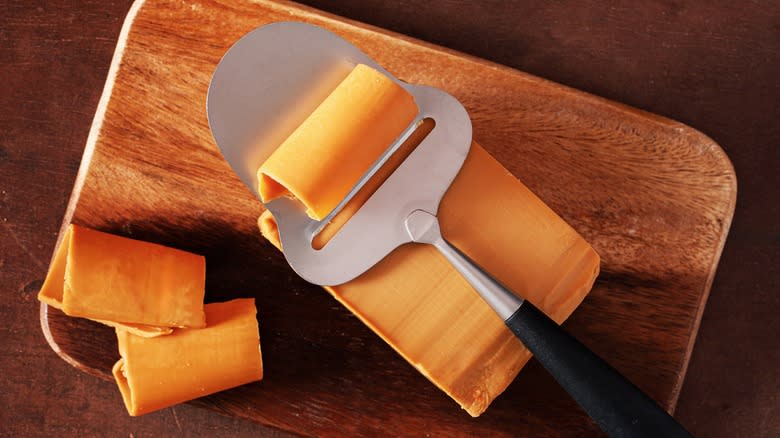
Any way you slice it, cheese is a fattening food. Cheese is rich in nutrients like calcium and protein, but because it's high in fat, it has a lot of calories. Also, many cheeses are salty, and cheese that is high in fat and sodium might not be the best choice for people trying to eat healthier. If you love cheese as much as we do, you shouldn't necessarily give it up — but it is good to have some knowledge about which cheeses are the unhealthiest in the grocery store.
The cheese selection at many grocery stores is full of variety, so how do you know what to choose? Certain soft cheeses pack a lot of saturated fat. Hard cheeses like feta and Parmesan have lower fat content but are high in sodium. This might make visiting the dairy section feel like choosing between the lesser of two evils — but don't get stressed. To help health-conscious eaters know which cheeses to avoid (or only eat occasionally), we're mapping out a list of cheeses that have slightly troubling nutrition facts. We'll get more detailed about how we determined which cheeses are the unhealthiest at the end of this article. What's important to know is that fat and sodium aren't the only nutritional drawbacks associated with cheese. There's also a lot of processed cheese out there, full of chemicals and additives. If you want to steer clear of unhealthy cheeses, consider crossing these 10 kinds of cheese off your shopping list.
Read more: 16 Little-Known Facts About Salt
1. American Cheese
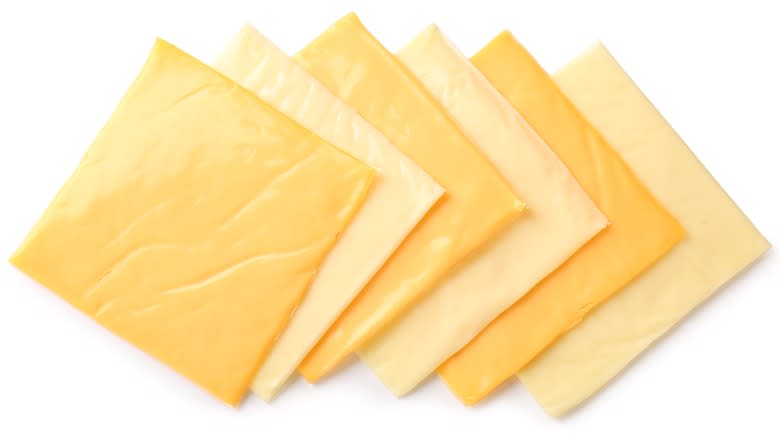
It's not a sophisticated cheese, but American cheese has its time and place. American cheese is made by melting cheeses like Cheddar, Colby, and Swiss together and combining the mixture with an emulsifying agent. American cheese is commonly sold in deli slices and can be white, yellow, or pale orange. It has a mild, creamy, salty taste and is great for melting, especially on grilled cheese sandwiches or burgers. Unfortunately, American cheese is heavily processed, which makes it one of the least healthy cheeses you can buy.
Most cheeses are preservative-free and only contain natural ingredients. Since American cheese is a blend, it uses binding agents like tricalcium phosphate to prevent caking. Preservatives like sorbic acid and lactic acid are also added. Due to these processing methods, American cheese is not a true cheese, but rather a "pasteurized processed cheese food" (per Wisconsin Cheeseman). Yellow or orange American is artificially colored — usually from oleoresin paprika, annatto, or both. If you buy individually packaged American cheese singles from brands like Kraft, even more unnatural ingredients will be present.
The Kraft Singles version of American cheese scores a 7 out of 10 on the Eat Well Guide's food scoring system — with 10 being the worst possible score. Eating one Kraft Single will set you back just 50 calories, but you'll also be ingesting genetically engineered ingredients like modified food starch. One slice of American cheese contains between one and 2 grams of carbs. Most cheese has none.
2. Mascarpone
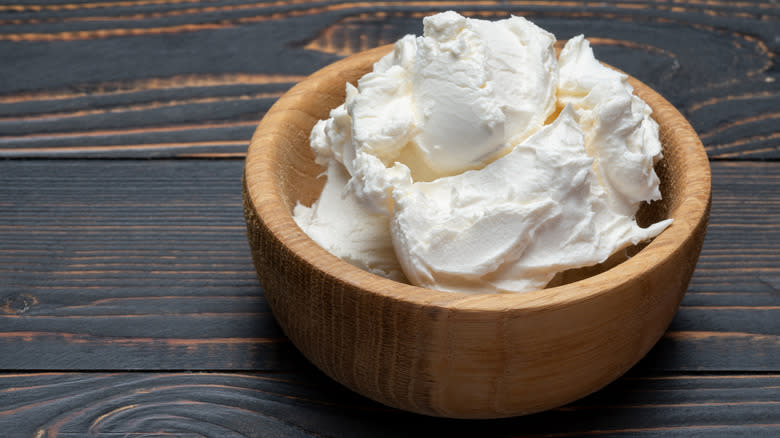
Spreadable cheeses are incredibly versatile, and when it comes to incorporating cheese into lots of different recipes, smooth, fluffy mascarpone is one of the best. Anything from lasagna to mashed potatoes, to cheesecake, and of course tiramisu, puts mascarpone to beautiful use ... but unfortunately, it's not the healthiest cheese. Mascarpone has been in existence since the Middle Ages. Its roots are exclusive to the Lombardy region of northern Italy where it was first sold as fresh cheese curds.
Mascarpone is a rich, triple cream cheese made by heating the cream from fresh cow's milk and stirring in citric or tartaric acid. Mixing the dairy and acid causes the cream to coagulate, then the liquid whey is drained from the mixture with a cheesecloth. This method produces a luxuriant cheese, albeit one that's higher in saturated fat than many other cheeses. With cheese, saturated fat comes with the territory, but 1 ounce (about 28 grams) of mascarpone is over 70% saturated fat.
1 ounce of mascarpone cheese has 13 grams of fat, 7.7 grams of saturated fat, and 0.2 grams of trans fat. An ounce of mascarpone also packs 124 calories and makes up 13% of your daily recommended intake of cholesterol. On the positive side, mascarpone is a good source of protein and low in sugar. If you want to use mascarpone in a recipe but don't want all the fat, you can cut it with something lighter but texturally similar, like Greek yogurt.
3. Double Gloucester
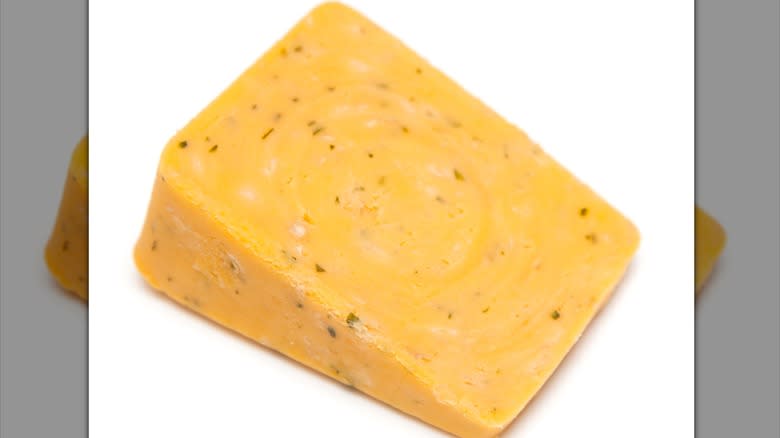
England is home to a storied cheese culture steeped in old-world traditions, and Double Gloucester is a quintessential product of that culture. As its name implies, Double Gloucester comes from the city of Gloucester. It originated in 1498, using the milk from Old Gloucester cows: a cattle breed that has battled the threat of extinction since the 1970s. It's also the star of the legendary Gloucester Cheese Roll, an annual occasion where people chase a rolling wheel of cheese down a 200-yard-long hill. The event draws thousands of spectators and garners international coverage.
Double Gloucester is a firm, crumbly cheese that is orange in color with a creamy, nutty taste. It is also one of the most fattening cheeses you can buy. Double Gloucester is made with full-fat milk and aged for around four months. A 1-tablespoon serving of Double Gloucester has 9.1 grams of fat, 6.1 grams of saturated fat, and 0.5 grams of trans fat. Of the 111 calories you get within 1 tablespoon of Double Gloucester, 77% come from fat. The 192 milligrams of sodium and 25 milligrams of cholesterol hardly help the situation.
Cholesterol and trans fat can clog your arteries and harm heart health, so eating cheeses like Double Gloucester should be done in moderation. Fans of this cheese do have a middle-ground option as Single Gloucester cheese is a less caloric option that uses skim milk rather than the full-fat variety.
4. Brunost
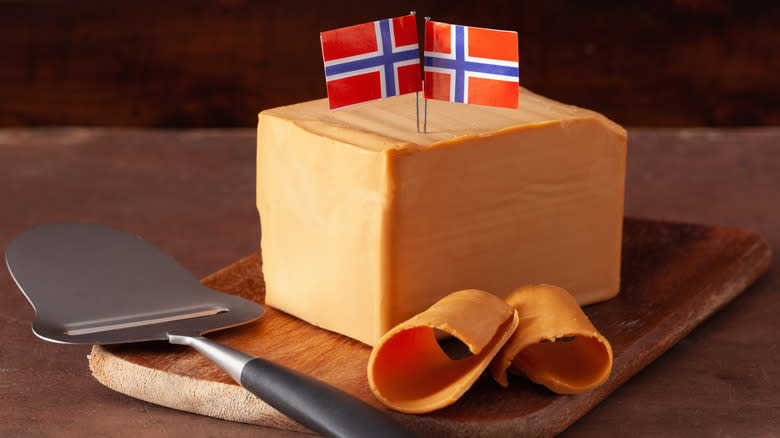
Depending on how international the cheese section at your grocery store gets you may (or may not) have heard of brunost, which translates to "brown cheese" in Norwegian. Brunost has long been a part of Norway's food culture. Different varieties are sold, including gjetost, Gudbrandsdalen, and Ski Queen. These brunost varieties are made with whey from goat's cheese, cow's cheese, or a blend of the two. Brunost is deep orange or brown with a dense, smooth texture, and it tastes sweeter than most cheeses.
Brunost rose to prominence in the 1800s when a milkmaid in the Gudbrandsdalen Valley created it by adding milk and cream to leftover whey and cooking the mixture until it caramelized. This cheesemaking method classifies brunost as a cheese product rather than a true cheese, and it's also why brunost is high in fat and sugar.
Unless you are of Norwegian descent, you're probably not eating brunost regularly. Brunost is innovative and tasty, but 1 ounce of the Ski Queen brand contains 130 calories, 9 grams of fat, and 6 grams of saturated fat. There are 7 grams of sugar, and 11 grams of carbs ... way more than other cheese imports.
Brunost's high sugar content is due to the caramelization process required to make it. As it turns out, brunost's caramelized nature makes it extremely flammable. In 2013, a truck hauling 27 tons of brunost caught fire in a tunnel and burned for five days. Luckily, no one was hurt in the blaze.
5. Cheese From A Can Or A Jar
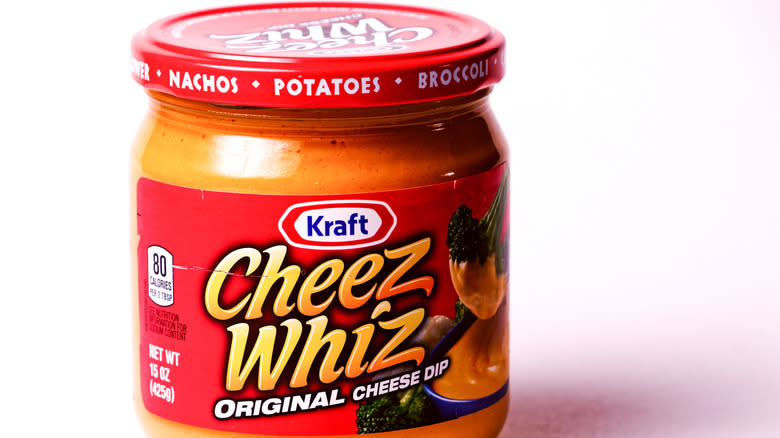
When you're food shopping, sometimes convenience wins over healthier options. Tempted to buy cheese that comes in a can or a jar, like Cheese Whiz or Easy Cheese? These heavily processed cheeses should be approached like a once-in-a-while junk food — because junk food is exactly what they are.
A gelatinous texture, uber-salty taste, and neon orange color are immediate indicators that these cheese products have a lot of chemical components. Two tablespoons of Kraft Cheez Whiz spread has 70 calories and 4.5 grams of fat. That's not so terrible, but the ingredients list is where things go downhill.
The main ingredient in Cheez Whiz is whey, the cloudy liquid left behind when cheese curds are drained. Milk and canola oil are added, followed by maltodextrin, an additive made from plant starch. Maltodextrin is in many processed foods. It elevates blood sugar and limits probiotic growth in your digestive system, which can hurt your gut health. Cheez Whiz's ingredients indicate one preservative after another, including milk protein concentrate, sodium phosphate, and modified food starch.
Easy Cheese, an aerated form of liquid cheese, is also unapologetically unhealthy. Ingredient-wise, it's very similar to Cheez Whiz. Two tablespoons of Easy Cheese has 80 calories and 6 grams of fat, slightly higher than Cheez Whiz. However, Cheez Whiz is higher in carbs — with 5 grams per serving compared with Easy Cheese's three. Both products contain 18% of the daily recommended value of sodium ... in just 2 tablespoons.
6. Brie
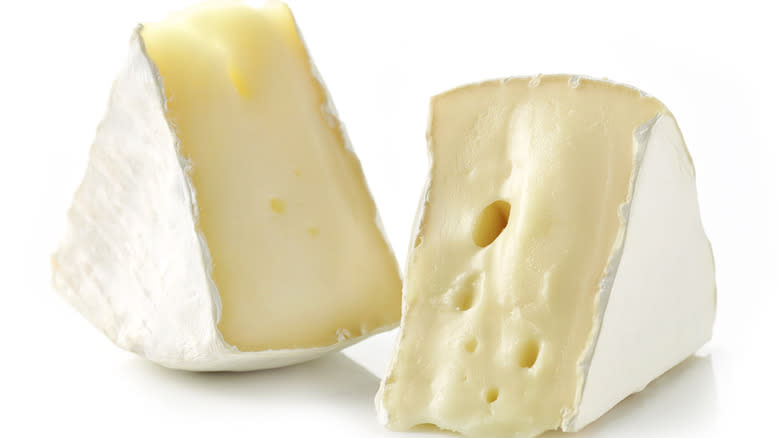
The French don't mess around when it comes to cheese, and among France's most well-known cheeses is Brie. This soft, cow's milk cheese is encased in a thin, edible mold rind and eaten by the wedge. Brie is highly versatile and sure to elevate any cheese plate it is part of. The downside? Brie's high levels of saturated fat mean it's not the healthiest of cheeses.
Brie is very similar to Camembert, another popular French cheese. Although Camembert contains more sodium than Brie, it has more protein, is less caloric, and is lower in fat. A 1-ounce serving of full-fat Brie has 100 calories and 9 grams of fat, with 4 grams being saturated fat. Triple Crème Brie provides a beautifully rich texture, but can up the calorie count even more (depending on the brand). A single ounce of Triple Crème Brie from the Joan of Arc brand is 120 calories — 99 of those calories come from fat.
If you love Brie but are watching your calorie intake, buying Brie made with reduced-fat milk is an option. That said, full-fat Brie's redeeming factor is how incredibly nutrient-rich it is. It is a great source of calcium which is crucial for bone health. Brie is full of vitamin A, known for facilitating healthy vision and organ production. Significant levels of vitamin B12 and riboflavin are present as well, to help your body produce energy. Brie is a cheese with benefits, but eating it in moderation is key.
7. Stilton
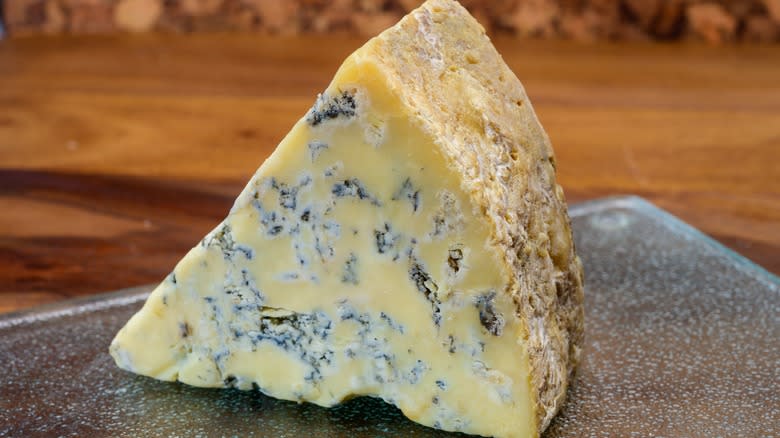
Cheeses out of the United Kingdom offer a storied history rivaling that of prestigious cheesemongering nations like Italy and France, and Stilton should absolutely be involved in the conversation of the world's great cheeses. Blue Stilton gets much of the limelight, but White Stilton also holds its own on the platform of historically revered cheeses. Then again, just because a cheese holds time-honored sophistication and tastes great doesn't mean it's healthy for you.
Blue stilton is characterized by its threading of blue mold spore -- a nontoxic mold created by distributing Penicillium roqueforti into the milk that will eventually be separated between curds and whey. The bacteria in the mold are activated during the aging process by being punched with stainless steel needles, oxidizing the spores.
This unique process is imperative in making blue cheese, giving way to numerous health benefits. Fermented dairy products are full of lactic acid bacteria, peptides, and fatty acids that can improve cognition and memory. Stilton is good for the mind, but is it bad for the gut?
The problem with blue cheese is that it has high amounts of fat and high amounts of sodium. Often, high-fat cheeses are low-sodium and low-fat cheeses have a lot of salt. White Stilton also has its flaws. The white version of this cheese tends to be blended with fruits inside, such as blueberries or apricots. Cheese studded with fruit adds sugar and carbs to the situation. Without fruit, cheese is typically free of sugar and carbohydrates.
8. Pre-Grated Parmesan Cheese
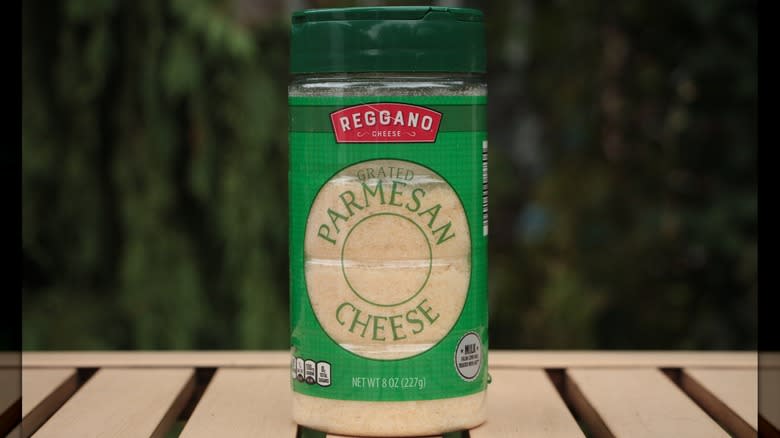
Parmigiano Reggiano — better known as Parmesan – is called the "King of Cheeses", and was first produced by Italian monks over a thousand years ago. Parmesan is one of the most widely eaten cheeses on earth, so demand is high. Plastic containers of pre-grated cheese are a grocery store staple, but you'll get more than just grated cheese when you buy one.
Authentic Parmesan is made from raw cow's milk, salt, and rennet. Many of the world's cheeses rely on rennet — enzymes from the stomach lining of calves, lambs, or young goats — to start the coagulation process of separating milk curds from the whey. Parmesan is a hard cheese, perfect for grating. Harder cheeses don't contain as much fat as soft cheeses, but they usually have more salt. After American, Parmesan is the saltiest cheese you can buy, with 390 milligrams of sodium per 1-ounce serving.
A modest amount of Parmesan on a pasta dish is hardly a crime, but you should definitely be buying it by the wedge instead of pre-grated. This might seem less convenient up front, but grating parmesan cheese fresh is always the healthier option. Preservatives like cellulose powder keep pre-grated Parmesan from caking, but it's worse than that. Cellulose powder is derived from sawdust or cotton lint. Some food brands don't just use it as a preservative, but also as a filler. Unless you have a hankering for spaghetti sprinkled with sawdust, keep pre-grated Parmesan on the shelf and not in your home.
9. Roquefort
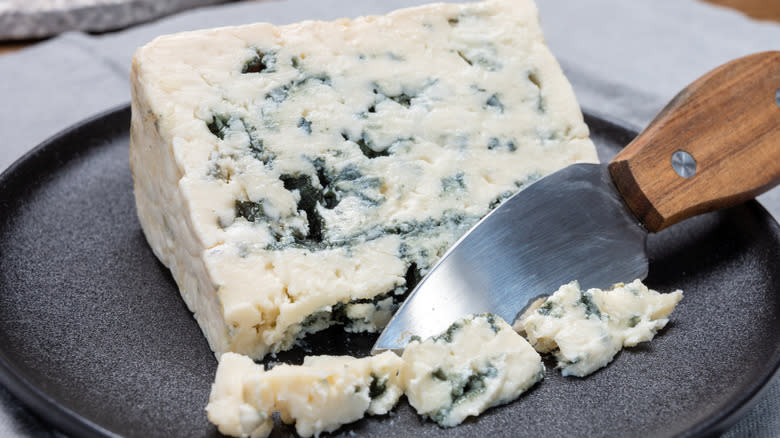
Any true cheese connoisseur knows the value of an expertly aged blue cheese. Roquefort is a blue (or shall we say bleu) cheese from France. This creamy, fermented cheese has a nuanced flavor profile, thanks to the impressive veins of blue mold running throughout. Roquefort is named for its mold cultures, known in all blue cheeses as Penicillium roqueforti. These mold cultures are nontoxic and provide health benefits, but in the case of Roquefort cheese, the benefits meet their match in the unhealthy downsides.
The health benefits of Roquefort, like being rich in calcium and containing anti-inflammatory properties are unignorable, however, the amount of fat and sodium that come with it puts a damper on its redeeming qualities. Just 1 ounce of Roquefort racks up 104 calories, of which, 74.7% is just fat. This isn't so out of character for cheese, but Roquefort also touts an unsettling amount of sodium compared to other cheeses. In 1 ounce, Roquefort carries 512.9 milligrams of sodium. Compared to a higher-calorie cheese like Cheddar, containing 120 calories, 10 grams of fat, and 190 milligrams of sodium per ounce, Roquefort's salt stats border on overkill.
We're not urging you to eschew a standout cheese like Roquefort entirely. Blue cheese can elevate any cheese plate and pairs equally well with fruit or a carb component like bread or crackers. Even so, for anyone aiming to lower their fat and sodium consumption, Roquefort is not one of the healthiest picks.
10. Pre-Packaged Shredded Cheese
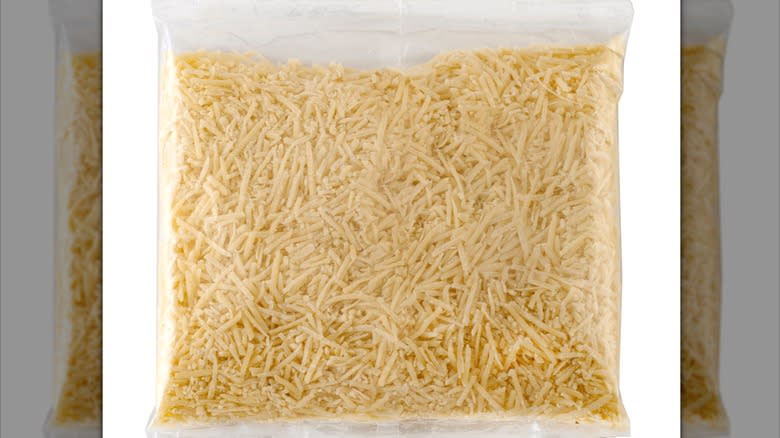
Who hasn't shopped for taco night and tossed a bag of Mexican-blend shredded cheese in the shopping cart? If you stop and examine the refrigerated wall of shredded cheese in the grocery store's dairy section you'll start noticing numerous blends geared toward specific cuisines and tastes. You've got your Five Cheese Italian medley of mozzarella, provolone, romano, Asiago, and Parmesan. Then there's the Farmstyle Triple Cheddar Blend, showcasing Cheddar in varying degrees of sharpness. What do all of these shredded cheeses have in common? Artificial additives.
Modified starches are used to prevent caking in every mass-produced pre-packaged shredded cheese on the market. These can include modified cornstarch, potato starch, and powdered cellulose. That's not all. A mold inhibitor called natamycin is also a run-of-the-mill ingredient in packages of shredded cheese. Natamycin is classified as a natural preservative, but Whole Foods kept this antifungal additive on its banned ingredients list for more than 10 years. It was also forbidden in the entire country of Lebanon where it was likened to poison.
Scientists have studied natamycin extensively and have concluded it doesn't pose any real threat to our health, but it's still an additive that most people probably wouldn't want in their cheese for any other reason except that it saves them the hassle of shredding it themselves. Any chance we have of avoiding preservatives is better for our health. Cheese is delicious naturally and injecting a bunch of preservatives into it majorly detracts from its beautiful simplicity.
Methodology
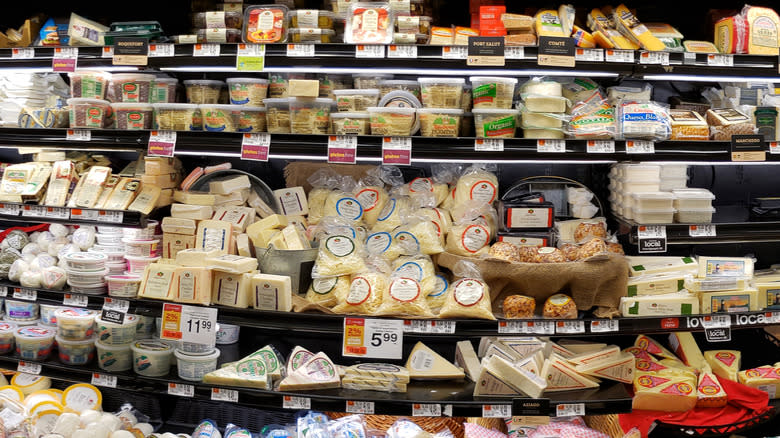
As devoted cheese lovers, we researched this article wanting to know more about why some cheeses have a bad reputation in the health department. This involved learning how different cheeses are made. Cheese is high in fat, simply because it's made from whole milk or cream, which naturally has a high fat content. We didn't villainize certain cheeses just for being fattening — especially when their health benefits outshine the calorie count. Cheddar, for instance, is a high-fat cheese, but because it's such a great source of protein, calcium, and vitamins, and has zero carbs and almost no sugar, we did not put this beloved cheese on our list.
After comparing the saturated fat content of many different kinds of cheese, super-rich varieties (like Triple Crème Brie or Double Gloucester) fell into the unhealthiest category. These cheeses should be eaten more like a treat than a daily part of a healthy diet. Cheeses that are high in saturated fat and sodium, like blue cheese, also found their way onto our list because, from a health standpoint, there are better cheeses you can buy.
Taking a natural food like cheese and adding all sorts of preservatives and other chemicals makes it far less healthy to consume. Chemically-altered cheese products like Easy Cheese and Kraft Singles are known for being unhealthier than pure, non-artificial cheese. Buying pre-shredded or grated cheese also means eating anti-caking preservatives, something that a lot of shoppers tend to overlook.
Read the original article on Mashed

